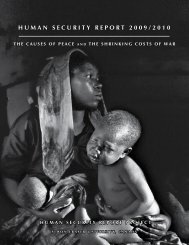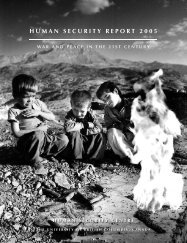H U M A N S E C U R I T Y B R I E F 2 0 0 6
H U M A N S E C U R I T Y B R I E F 2 0 0 6 - Human Security Report ...
H U M A N S E C U R I T Y B R I E F 2 0 0 6 - Human Security Report ...
Create successful ePaper yourself
Turn your PDF publications into a flip-book with our unique Google optimized e-Paper software.
Peace agreements that follow wars over control of a governmenthave very different settlement terms. The UCDPstudy found that there was a provision for elections in 48%of the settlements under review, and in a substantial minorityof cases there were also provisions for creating an interimgovernment, for integrating rebels into the government and/or civil service, and for establishing the right to create politicalparties. 48 While some researchers have stressed the importanceof power-sharing pacts for the successful implementation ofpeace agreements, UCDP found that only 15% of agreementsending conflicts over government control had a provision forpower-sharing.Negotiated settlements are threetimes more likely to fail than victories.The military provisions of peace settlements that seekto end intrastate conflicts were fairly consistent regardlessof whether the fighting was about territory or the control ofgovernment. There were provisions for ceasefires in 60% ofsettlements, disarmament in 44%, integration of rebel forcesinto the national army in 38%, amnesties in 28%, and peacekeepingmissions in 23%.Further research in this area could help determine whichsorts of political and military settlement provisions have beenmost effective in helping implement settlements of differenttypes of conflict. Such findings would be of considerable utilityto the policy community and could help reduce the highfailure rate that has characterized peace settlements since theend of the Cold War.The Downside of Negotiated SettlementsThe big increase in negotiated settlements over the pastdecade and a half suggests that the international community’sgreatly increased efforts to bring wars to an end in this periodhave had a positive effect. But the data also suggest that negotiatedsettlements have two significant downsides comparedto the victories they appear to be replacing.First, wars that end in negotiated settlements last almostthree times longer on average than those that are ended bymilitary victory.Second, negotiated settlements are three times moreprone to failure than are victories.The fact that victories are more stable than negotiatedsettlements is not surprising. When wars end with the militarydefeat of one of the parties, the loser has no capacity tostart fighting again, while the victor has no interest in doingso. But in negotiated settlements, where neither side has beendefeated, the warring parties often retain substantial militarycapabilities well after peace agreements have been signed.Committing to peace in environments characterized by hostilityand lack of trust is extraordinarily difficult. Seeking amore advantageous outcome by returning to war remains anoption—and one that is often pursued.The fact that negotiated settlements are associated withlonger wars and a greater risk of reoccurrence than are victoriesmight suggest that seeking decisive outcomes on the battlefieldwould be preferable to pursuing negotiated peace agreements.But as the short essay “Give War a Chance?” argues, this optionis neither practical nor desirable (see next page).In the 1990s negotiated settlements became much moreunstable. 49 During the decade, 43% of all conflicts that endedin negotiated settlements started again within five years, comparedwith just 9% of conflicts that ended in victories. 50 (Fiveyears without a restart is the standard measure of success fora negotiated settlement.) The average failure rate for peacesettlements in the Cold War years had been just 13%.Many of the negotiated settlements signed in the decadefollowing the end of the Cold War appear to have been inappropriatelydesigned, ineptly implemented, and poorly supported—hencetheir high failure rate. But the sheer number ofnew settlements more than offset the effect of their increasedfailure rate.In the 1990s, 24 of the 42 negotiated settlements succeeded—i.e.,fighting did not restart within five years. Thismeant that—despite the large number of failures—the 24successful settlements during this decade were more thantwice the average of each decade in the Cold War years.The average failure rate for peacesettlements in the Cold War yearswas just 13%.The category of conflict terminations that has the highestprobability of failure are, unsurprisingly, those that end inneither a victory nor a peace agreement, but where the fightingsimply dies down completely or falls below the 25 battledeath-a-yearthreshold. This form of termination lacks boththe military advantages of victory and the political guaranteesthat often accompany negotiated settlements.H U M A N S E C U R I T Y B R I E F 2 0 0 6 21






